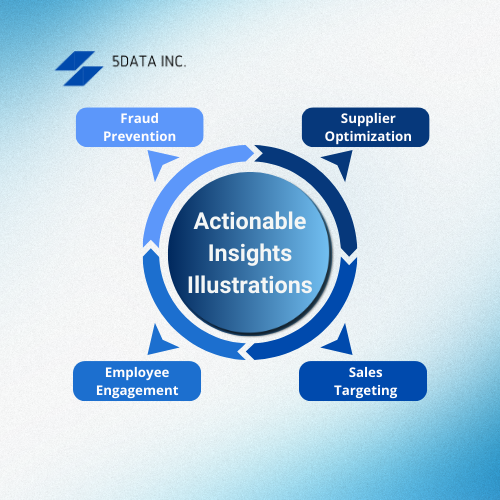Difference Between Data And Insights
Data is a raw and unprocessed form of information containing numbers, audio, images, texts, etc., primarily in different formats and systems. Without the fundamental processing steps, data doesn’t make sense or provide valuable information to your business. Hence, clean and good data can gain actionable insights.
Insights are produced by analysis and conclusions. It is a crucial step that could make or break an organization’s capability to comprehend its data better to maximize its profits, reduce costs, and create value for stakeholders. Hence, most businesses seek data analysts with good grip and skills in data analytics.
Best 10 Strategies To Turn Data Into Actionable Insights
Let us learn 10 Strategies to turn data into actionable insights:
1. Understanding what to measure
Possessing knowledge of what is to be measured is a key factor. Otherwise, countless hours go wasted working and analyzing unnecessary data that does not align with the business goals. However, data-mature businesses will have the required processes and work on data analysis that drives business growth.
Companies with a measurement plan tend to quickly track organization goals and key performance indicators (KPIs) to meet business goals that help to track business performance and progress to ensure the achievement of business objectives.
2. Building a data-driven culture
A data-driven culture allows employees to collaborate and share data. Employees are authoritative to make a decision that is appropriate to their role. Companies with data-driven cultures educate their employees with data-related knowledge and skills. Data mature organizations help employees improve their data literacy skills. There are various levels of data literacy, and employees must have the required data literacy about their roles in power business strategy. Business leaders and teams share a common framework and language around them.
Good Data Life Cycle Management Services provide structure and organization to a company’s data, enabling key goals like availability and security.
3. Recognizing and extracting patterns
Data analysis will allow you to extract patterns from it. Such patterns reflect actional and valuable insights and create opportunities that have never been before. Pattern extraction could turn your information into valuable knowledge and show a better understanding of customer behavior.
Anomalies in the data give clear insights into unusual situations that need investigation. Patterns reflect critical factors and prioritize processes making the business more productive. Mastering pattern recognition allows businesses to create new opportunities, find solutions, and manage situations.
The Data Collection And Data Management Service Providers help in data cleaning and management, fundamental steps in data analytics.
4. Verbalizing your research
It is important to verbalize the insights effectively to business leaders and stakeholders to ensure your business is in the right direction.
As there is access to so much data, and not all the data is useful for business, mastering the art of identifying critical data sets helps your research to be more focused and targeted.
Furthermore, precisely communicating what you have researched with data ensures employees on the team are on the same page and allows the stakeholders to make data-driven decisions. However, when the appropriate parties are given accurate data, they can execute decisions that power the business strategies.
5. Focusing on data sources
Business data comes from multiple sources and is most likely to have issues like null values, outliers, missing data, etc. Data cleaning and processing are crucial steps. Faulty data sets could lead to wrong information and further confusion for decision-makers in the business; collecting data from different sources and connecting them helps the organization make better decisions for business processes. Data scientists analyze a data set from a data mart, allowing them flexibility with access to fast insights.
6. Powerful data visualizations for effective communication
Representing your data using data visualization will greatly affect the outcome. It is very important to articular the data story with what and how to convey it efficiently to provide actionable insights and promote better business decisions.
7. Building a solid optimization plan
Executing the Define Measure Analyze Improve Control (DMAIC) process will improve your business. It is one of the efficient six sigma concepts that can be executed directly. It defines the problem of stakeholders, the hypothesis, and the scope of the analysis. It measures relevant data and conducts data analytics to detect anomalies. It analyzes the correlations and patterns and improves your data visualization skills. It improves based on insights and shows several options to explore. It controls the test by deploying and controlling KPIs.
8. Breaking the organizational silos
A healthy organization is a foundation for a successful company. Inspiring, motivating, and inquisition to know about the real-time data and making critical business decisions to improve the position will have a positive impact.
9. Construction of great hypothesis
A clear hypothesis is the beginning of any analysis. The hypothesis should be capable of driving the actions. Create a hypothesis by completing these two statements 1. I believe __________ (hypothesis), 2. If I am right, we will _____________( qualification). Formulating these fill-in-the-blanks isn’t always easy. But you would save a ton of time by doing it.
10. Applying visual analytics
Once data collection, cleaning, and collation are done for accuracy and valuable insights, the next step is to apply visual analytics teams. Most organizations use this step to go beyond the traditional spreadsheets to uncover hidden patterns and crucial information.
Visual analytics represent the data in a highly graphical and visual format via interactive dashboards, graphs, charts, reports, summaries, and maps and provide clear visualizations of the extracted information from patterns. Additionally, this step reduces human errors and displays clear information.

Examples of Actionable Insights
Let us explore some real-time examples of actionable insights:- Fraud Prevention: Identify error or fraud patterns after analyzing accounting data and execute steps to prevent losses.
- Supplier Optimization: Identification of preferred suppliers for engagement to reduce costs and work with on discounts.
- Employee Engagement: Measure employee engagement and take steps based on analysis to improve productivity.
- Sales Targeting: To increase sales volume, identify items to sell in particular areas based on cross-selling data.
Conclusion
Extracting insights from raw data and applying predictive models are crucial for a company. Companies that offer efficient data cleaning and management steps for extracting valuable insights can be classified as notable Data Collection And Data Management Service Providers.
